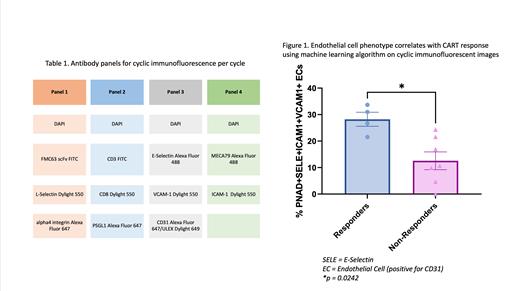Chimeric antigen receptor T (CAR-T) cell therapy targeting CD19 only results in complete remission in approximately 30-40% of relapsed/refractory disease patients with diffuse large B-cell lymphoma (DLBCL). Failure may result from lack of CAR-T entry into the tumor. Endogenous T cell homing is initiated by binding to post-capillary venular endothelial cells (ECs). Naïve and central memory T cells use L-selectin binding to peripheral node addressin (PNad) on high endothelial venules (HEVs) of the lymph node while circulating effector memory T cells, lacking L-selectin, use other molecules to bind cytokine-induced endothelial proteins E-selectin, ICAM-1 and VCAM-1 on flat venules of inflamed tissues. Both of these venular EC types are present in inflamed lymph nodes. We hypothesized that the expression patterns of adhesion molecules on venular ECs in pre-treatment tumor biopsies could predict CAR-T efficacy.
To test this, we applied cyclic immunofluorescence to 18 archived pre-treatment DLBCL patient FFPE biopsies (8 responders and 10 non-responders, defined by relapse at 12 months). We detected venular ECs using a combination of anti-CD31 and UEA lectin on larger diameter vessels and assessed expression for PNad, E-selectin, ICAM-1, VCAM-1. We detected endogenous CD8+ T cells and evaluated their expression of L-selectin, alpha 4 integrin and PSGL-1. See table 1. DAPI nuclear staining was included in each cycle. Images of each cycle were combined in ImageJ and imported into QuPath for analysis. Using Warpy, affine transformations were applied to DAPI staining to create overlays between imaging cycles. After alignment, representative images of several samples were randomly chosen for image training using a combination of Artificial Neural Networks (ANNs) and classifiers to perform identification and mask tissue regions of vessels and T-cells within the tissue. Positive and negative cells for each marker of interest (EC PNad, ICAM-1, E-Selectin, VCAM-1, and T cell alpha 4 integrin, L-Selectin, and PSGL-1) were used to create classification algorithms to determine marker expression for ECs and T-cells within the tissue. Results were analyzed by unpaired t-test and one-way ANOVA conducted in Graph-Pad Prism 9 software.
Preliminary results from quantitative analysis of pre-treatment biopsies show a significant increase in CD31+/PNAD- venular ECs compared to non-responders that were double positive for ICAM1 and VCAM-1 (p=0.0273). This analysis also revealed a significant increase in CD31+/PNAD+ HEV ECs from responders that were triple positive for E-Selectin, ICAM-1, and VCAM-1 (p=0.0242). See figure 1. Our initial semi-quantitative analysis showed a trend toward elevated numbers of tissue-infiltrating CD3 + CD8 + T cells in the pre-treatment biopsies of responders. T cells expressing PSGL-1, a glycoprotein that may carry carbohydrate moieties recognized by E-Selectin and linked to T-cell exhaustion, was increased in the non-responder cohort.
These data suggest an increased extent and activation state of intra-tumoral venular ECs and increased endogenous T-cell infiltrates, which may predict the outcome of CAR-T therapy. Analysis of T-cells in the pre-treatment biopsies leveraging machine learning algorithms is in progress and both complete quantitative findings and prognostic value of this approach will be presented. While our findings require further validation thru additional biopsy analysis, they provide emerging evidence for a rationale involving vascular readiness in DLBCL responder differences to CART therapy.
Disclosures
Isufi:Beam Therpauetics: Consultancy; ADC Therapeutics: Consultancy; Gilead: Consultancy, Current equity holder in publicly-traded company; Genmab: Consultancy; Abbvie: Consultancy; Incyte: Consultancy.


This feature is available to Subscribers Only
Sign In or Create an Account Close Modal